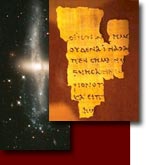| Site Map | Contacts | Links | Newsletter | |
Old Testament:
Egyptian
Egyptian Hieroglyphics also can be helpful. Some creation stories are similar to Genesis, as well as their view of the world. Egyptian wisdom literature is also similar to the book of Proverbs and the Song of Solomon.
With the discovery of the Rosetta Stone by a soldier of Napoleon's army, Champollion was able to decipher the ancient Egyptian Hieroglyphics in 1822 (Millard 1985, 26-7).
There are several stages in the development of the Egyptian language. Old Egyptian was used from Dynasties I-VIII. An example is the Pyramid Texts. Middle Egyptian was used from Dynasties IX-XI. Late Egyptian was used from Dynasties XVII-XXIV. A cursive writing known as Hieratic (Greek meaning "priestly") was used for documents which is like Egyptian shorthand. Later Demotic (Greek meaning "popular") emerged which is a rapid form of Hieraitic which was used in books and documents from Dynasties XXV (715 BC) to late Roman times (470 AD).
Finally, the early Egyptian Christians used Coptic which is Egyptian written with the Greek alphabet. There were three dialects of Coptic; Akhmimic used in upper Egypt which gave way to Saidic, and Bohairic used in all of Egypt. The Nag Hammadi papyri was written in Coptic and gives us a window into the beliefs of the Gnostics which means "knowledge" (Robinson, 1977). The most famous book is the Gospel of Thomas which has Gnostic sayings of Jesus (Guillaumont et al, 1959).
